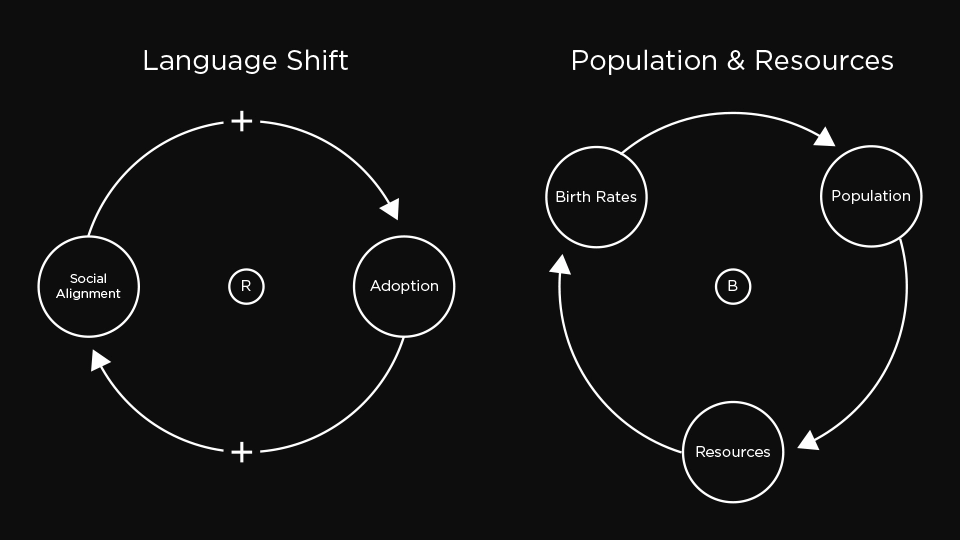Module 2: Feedback Loops and Causality – Lesson 1
This lesson is just one part in our series on Systems Thinking. Each lesson reads on its own, but builds on earlier lessons. An index of all previous lessons can be found at the bottom of this page.
Systems rarely move in straight lines. Instead, they circle back on themselves, with actions producing consequences that loop around to shape future actions. These recursions—known as feedback loops—are the heartbeat of system dynamics. To grasp them is to understand why some patterns spiral out of control while others stubbornly resist change. In this lesson, we will explore two foundational loop types: reinforcing loops, which amplify momentum, and balancing loops, which impose stability. Together, they generate the push and pull that defines system behavior in everything from global culture to the fortunes of a brand.
The Two Core Concepts
A reinforcing loop is the engine of compounding change. When one variable increases, it triggers a series of effects that circle back to make the increase larger still. The more something grows, the more it fuels its own growth. Viral memes, protest movements, and chain reactions all carry the signature of reinforcement. They do not “seek balance”—they seek acceleration, whether upward into success or downward into collapse.
A balancing loop operates in contrast, as a stabilizer. It constantly compares where the system is with where it “should” be—an implicit or explicit goal—and it exerts pressure to close the gap. Like a thermostat keeping a room near its set temperature, balancing loops act to counter disruption. They explain why entrenched habits resist change, why supply chains adjust after a surge, or why political order reasserts itself after moments of upheaval. These loops embody the system’s instinct for equilibrium.
How We Identify Them
When we’re investigating a system, the loops are often hidden under the surface. They’re not usually labeled “reinforcing” or “balancing”—we have to detect them. Here are some ways to do that:
Looking for Patterns Over Time
- Ask: Is this situation spiraling (up or down)? → likely reinforcing.
- Ask: Does it hover around a stable point or resist change? → likely balancing.
Examples: recurring boom-and-bust cycles, or how communities rebound to a cultural norm after disruption.
Paying Attention to Delays
Loops often aren’t obvious because effects show up later than causes.
- Reinforcing loops sometimes look flat until they suddenly accelerate (like exponential growth).
- Balancing loops often “kick in” only after things overshoot (like weight gain leading to health interventions).
Spotting those lags is key to recognizing the loop at work.
Listening for Language Cues
People often talk in terms that hint at loops, even if they don’t know the formal notation.
- Reinforcing clues: “It snowballed,” “It got out of hand,” “Everyone started jumping on the bandwagon.”
- Balancing clues: “Things evened out,” “We hit a limit,” “It corrected itself.”
These everyday metaphors are often windows into hidden dynamics.
Tracing Consequences
If something keeps happening, ask: What’s feeding this trend? What circles back to reinforce or counter it?
- Example: Why do housing prices keep climbing? (Reinforcing demand → higher investment → higher prices → more demand.)
- Example: Why hasn’t a protest movement grown past a certain size? (Balancing pushback from authorities, resources, or public fatigue.)
Surfacing Goals—Explicit or Hidden
Balancing loops almost always orbit a goal, whether conscious or not.
- Thermostat → temperature setpoint.
- Cultural taboos → preserving cohesion.
If you can articulate the “target state” the system is defending, you’ve probably uncovered a balancing loop.
Switching Perspectives
What looks like a reinforcing loop from one angle may reveal balancing from another. For instance: A city “always growing” may look like runaway reinforcement, but dig deeper and you’ll find balancing forces—traffic congestion, cost of living, zoning—that check its growth.
So, in practice, uncovering these dynamics means slowing down, watching for patterns over time, and asking what is circling back on what. Instead of looking at a single event, we look at the “storyline” and what keeps pushing it forward—or pulling it back.
How We Leverage Them for Insight
Recognizing a reinforcing or balancing loop isn’t just about labeling; it gives us leverage for insight and action.
Anticipating Where the System Is Headed
- Reinforcing loops tell you: “If nothing interrupts, expect acceleration.” Growth may become explosive, decline may collapse faster than expected.
- Balancing loops tell you: “This system will resist change.” Expect pushback, inertia, or oscillations around a set point.
This foresight helps you avoid being blindsided by momentum or hidden resistance.
Locating Points of Intervention
- In a reinforcing loop, small nudges early can have outsized effects later. If you want to promote a movement, amplify early adopters. If you want to prevent harm, interrupt the loop before it gains traction.
- In a balancing loop, leverage comes from adjusting the goal (what the system is trying to stabilize around) or reducing delays (which can cause oscillations or overshoot).
Explaining Stubbornness or Volatility
If something won’t budge despite effort, that’s likely a balancing loop protecting a hidden goal. If something is spiraling out of proportion, it’s probably a reinforcing loop left unchecked. Naming the loop type helps explain why a system is behaving the way it is.
Spotting Hidden Drivers of Behavior
Loops often make clear what’s really powering a system. For instance:
- Reinforcing: why misinformation spreads online faster than corrections (shares → visibility → more shares).
- Balancing: why a community absorbs cultural change slowly (norms push back until generational turnover shifts the goal).
Instead of focusing on surface events, you get to the underlying engine.
Shifting Perspective from Events to Dynamics
Events are one-off; loops reveal ongoing tendencies. Once you see the loop, you stop reacting piecemeal and start thinking structurally: “This isn’t just this protest, it’s a reinforcing cycle of awareness and repression,” or “This isn’t just a bad quarter, it’s a balancing loop around resource limits.”
Preparing for Interactions Between Loops
The real insight often comes not from a single loop but from how reinforcing and balancing loops collide.
- A reinforcing loop builds pressure (e.g., population growth).
- A balancing loop eventually limits it (e.g., resource scarcity).
Seeing both gives you a sense of when growth will stall, or when a correction will overshoot.
In short: acknowledging loop dynamics shifts your questions. Instead of “Why did this happen?” you begin asking “What is feeding this? What is countering it? Where is the leverage if I want to guide it?” That change in perspective is where systems thinking becomes powerful.
Real-World Examples
One of the clearest reinforcing dynamics in cultural life is language shift. When a community begins adopting new words or phrases—whether borrowed terms, slang, or digital shorthand—the early adopters model belonging. Others copy them, eager to align with the group. As adoption spreads, the cost of not using the term increases, since outsiders risk appearing out of step. Each new speaker reinforces the momentum, and the usage accelerates. The viral spread of internet acronyms or the gradual dominance of English in global commerce exemplifies this pattern: once momentum gathers, it becomes self-sustaining.
By contrast, population and resources illustrate a balancing loop on a global scale. As populations expand, they place greater demand on food, water, energy, and land. Resources, however, are finite. As scarcity increases, birth rates may decline, mortality may rise, or societies may adapt through migration and technological innovation. These mechanisms counteract unchecked growth, pulling populations back toward what ecosystems or economies can sustain. History is littered with examples—from ancient civilizations managing irrigation to modern debates on climate and carrying capacity—of populations meeting the firm hand of balance.
Where It Gets Interesting
The richest insights come from seeing how reinforcing and balancing loops collide. Language shift and population dynamics together show this tension clearly. Reinforcement explains how quickly new ways of speaking spread, but balance reminds us that there are limits—whether generational turnover, cultural identity, or institutional resistance—that slow or redirect change. Similarly, population growth can feel like an unstoppable reinforcing surge, but balancing loops in the form of scarcity, policy, or social adaptation push back.
It is at these intersections that culture and society take their shape. Reinforcement pushes forward with energy and acceleration; balance holds back, demanding stability. Neither force “wins” outright. Instead, their ongoing negotiation creates the dynamic middle ground we actually live in—language that evolves without erasing heritage, populations that grow but confront the discipline of resources. This tension is not a flaw in the system; it is the system at work.
Applied Example: Branding and Marketing
Inside organizations, reinforcing and balancing loops quietly shape the arc of brands. Word-of-mouth is perhaps the marketer’s purest reinforcing loop: delighted customers share their experience, drawing in new buyers who, in turn, generate more delight and more sharing. A similar flywheel emerges in content and visibility—consistent publishing builds engagement, algorithms reward engagement with reach, and reach motivates even more content.
Yet every reinforcing surge meets its balancing counterpart. A marketing campaign that brings in new clients strains operational capacity; quality falters, and churn rises, leveling growth. Bold creative ideas are generated, only to be drawn back toward the “safe” core by internal review committees. Heavy promotion excites early adopters but soon meets audience fatigue, dulling returns. These balancing loops are not failures of strategy—they are the system’s brakes, holding behavior near its set point.
For leaders, the key is discernment. When something stalls, is it because the idea was weak, or because a balancing loop is quietly pushing back? When something soars, is it mere chance, or the signature of reinforcement that can be cultivated with care? To see these loops is to see the real drivers of momentum and resistance.
Notation: Capturing Loops Visually
To share and analyze feedback, systems thinkers use Causal Loop Diagrams (CLDs). Their notation is simple but powerful:
Arrows
Arrows show cause-and-effect, linking variables. Example: Customer satisfaction → Word-of-mouth.
Polarity
Polarity (+ or –) marks the direction of influence.
- A “+” means both move the same way.
- A “–” means they move in opposite directions.
Loop Labels
Loop labels identify type: R or ⟳ for reinforcing, B or ⊖ for balancing.

With just these marks, we can map the invisible engines of behavior. A reinforcing loop of customer delight becomes a circle of arrows labeled with “R.” A balancing loop of capacity constraints gains a “B.” These simple diagrams let us make the hidden visible, turning vague hunches into shared understanding.
Conclusion
Reinforcing and balancing loops are the twin forces of system dynamics—one accelerating, the other restraining, always in dialogue. They explain why some efforts spiral upward, why others collapse, and why many simply hold steady. For those working within complex systems, whether in culture, governance, or branding, loops offer a way to see the structure beneath events. To recognize them is to move from reacting to anticipating, from frustration to clarity, and from scattered effort to strategic leverage.
Course Index
- Module 0: Introduction to Systems Thinking
- Module 1: Components of Systems
- Module 2: Feedback Loops and Causality
- Lesson 2.1 — Reinforcing and balancing loops

